#America studio version edit
Text
youtube
14 notes
·
View notes
Text
Interview with Chris Keyser, co-chair of the WGA’s negotiating committee, on 100 days of the strike
'Chris Keyser, the co-chair of the Writers Guild of America’s negotiating committee, doesn’t see the 100-day marker of the ongoing strike as a moment to celebrate. In fact, Keyser has a few choice words for the Hollywood studios and streamers who comprise the Alliance of Motion Picture and Television Producers, calling the anniversary of the work stoppage “shameful” and “a day of infamy.”
In an interview posting Friday as part of The Hollywood Reporter’s TV’s Top 5 podcast, Keyser talks about the stalled state of negotiations with the AMPTP, why companies boasting about cash savings during the work stoppage is a “smokescreen” and his thoughts on what it will take to get both sides back to the negotiating table.
Below is an edited and condensed version of the TV’s Top 5 interview with hosts Lesley Goldberg and Daniel Fienberg. You can listen to the full conversation when episode 226 posts on Friday morning. (Subscribe here.)
Walk us through what happened with the Aug. 4 talks where both sides reunited to see if there was a path forward to resume negotiations.
Keyser: It didn’t go perfectly well, obviously. The conversation turned on Carol [Lombardini, president of the AMPTP] saying, “We’re going to talk about some things” and Ellen [Stutzman, chief negotiator of the WGA] saying, “You’re going to need to talk about everything.” And Carol saying, “I need to get back to you and talk to my member companies.” We’re waiting to hear. So, a stutter step but not really worth worrying too much about in the long run. [After the meeting THR reached out to the AMPTP, which did not comment.]
How was the temperature of the room when you walked in versus when you walked out?
Keyser: Things are cordial with the AMPTP. People are not yelling at each other. Everything is very professional; coldly professional, probably. The coldness is metaphorical. But no one needs to worry about that. The WGA is not particularly interested in playing games. Talking is the only way forward. There’s a sense somehow that you label something 100 days like it’s some kind of celebration. It’s an anniversary of shame for the AMPTP, let’s be clear about that. There was that early comment in the press about trying to starve us, and then they walked that back. But of course they are. We can make a TV show in 100 days; they can’t seem to get back into the negotiating room and have one substantive conversation. It’s a day of infamy for the AMPTP. It’s shameful. Either they cannot get it together or they intentionally are not getting it together. Or the AMPTP is doing precisely what they claimed they wouldn’t do, which was to try to create a situation in which people who are hungry and desperate no longer have the will to fight for their own survival. That’s not going to work.
Do you have an idea of when talks are going to resume?
Keyser: I don’t know. It’s impossible to get inside their heads. They could be negotiating among themselves about what they’re willing to offer. They could be delaying for the sake of delaying. At some point, I almost don’t believe that anymore. There’s a difference between the companies and the AMPTP itself. There were reports that said Carol didn’t want to meet last Friday. I don’t know if that’s true or not. You can never quite tell [what’s going on] behind that curtain. All the chatter you’ve been hearing from the companies — all of the reports of outreach — that’s because the companies have come to understand that this is no longer a tenable strategy and Wall Street’s repeating it: “We don’t understand what the companies are doing.” “This no longer makes sense.” “They can’t work without product.” It’s an inevitability that companies that make TV and film have to go back to making TV and film — with an asterisk that who knows what Amazon and Apple are up to because they could never make another program and it wouldn’t affect their bottom line. That’s part of the problem with the industry: It has players in it for whom the thing that we all love and value is an asterisk.
One of the things that you’ve been talking about is the possibility that the individual members of the AMPTP do not necessarily have the same agenda and that at some point they could splinter. As we are at 100 days, from your perspective, does that seem more or less likely?
Keyser: It’s hard not to look at the situation and see the differing interests of the companies and the ways in which this strike affects them differently means that at some point, they may need to assert their own interests rather than the interest of the group. I’m not surprised that no one has broken off yet because the AMPTP process has been highly effective for them in putting downward pressure on labor. So, in some sense, I think it needs another step for that to happen. I can easily imagine that Carol would say, “You have to give me a chance to go back in and negotiate.” She’s going to have her chance. It does not entirely make sense for Warner [Bros. Discovery] to tie its future to Apple’s point of view about the industry if Apple is intransigent. Apple [for example] would be fine, and Warner would disappear.
There was a sense of optimism, going into Friday’s meeting, from guild membership that seems to now have evaporated. How important is it for both sides to be at the table talking?
Keyser: There’s always optimism because you can’t be in a struggle for 100 days and not say, “There’s a tiny light at the end of the tunnel.” I just don’t know how long the tunnel is. We put out an email to the membership the Thursday before reminding them that of the AMPTP “playbook.” I use that term meaningfully because they do tend to go back to the same strategy over and over again — not to come right back in and say, “OK, what do you need? Let’s make a really good deal” — but to see how little they can give us. In 2007-08, they did it and talks led to breaking off. Even if we get back into a room, I don’t put it past them to continue to say, “We’ll give you a little bit.”
The AMPTP’s line is the DGA pattern and then a few other things. That’s the same way they negotiated a non-conflict negotiation. That’s what they did in 2020, during COVID. But they’ve got two guilds — 170,000 people — out on strike. You can’t just use the same line over and over again and expect it to apply to every single situation. At some point, that becomes useless obstinacy. We’re going to talk at some point because the companies can’t afford not to.
When you hear concretely that the DGA deal is going to be what they’re offering, how do you respond?
Keyser: The DGA deal was never going to be a meaningful pattern for us. There are pieces of this — like success-based residuals — that the DGA felt like it didn’t need and we feel that we do. The DGA doesn’t get to make our deal. The DGA made the deal that it needed to make. But the companies can’t use that deal as our settlement, because 170,000 people are on strike telling them that that’s not going to be sufficient and it doesn’t allow us to survive in this industry.
Companies are caught between a Wall Street regime that requires certain things of them that are hard in the middle of transition — free cash flow and growth — and the ability to deal with the fact that practices that they have adopted over the last decade have driven their workforce closer to being unable to survive. They have to figure out a way to compensate their workforce fairly, even as they have that sound in their ears saying, “Wall Street wants profitability,” “Wall Street doesn’t want to spend money.” They’re going to have to get through that, because not having us working only hurts them in the long run. It only diminishes their power in the business. It’s disruptive. They don’t even have to listen to me; they can listen to all of these Wall Street analysts.
The 2007-08 strike lasted 100 days, with negotiations resuming after 21 days. What is your expectation for how long the writers strike will go on?
Keyser: There’s no way for me to know that. Once they get into a room and they’re open to having real conversations, you do go very fast. Real negotiations don’t take very long. It’s really a question of how long it’s going to take the companies to say, “We understand that we have no choice but to sit down and have a real conversation.” I can’t determine that. When the broadcast season begins to evaporate, when Sony moves all of its movies from 2023 to 2024, when you look ahead to next year and you say, “What is Warner going to program on HBO once they get through this?” How do they manage that, month after month after month? They’re going to make a deal with us. That deal is going to be some version of what we’re looking for. If they keep us longer, that price doesn’t go down. All that’s going on now is they’re compounding their losses.
Taylor Sheridan is one of the most successful working TV writers in this moment. He told THR in a cover story this summer that he didn’t support the minimum room size, which is one of the WGA’s core issues. Others have echoed those sentiments, including John Ridley. What do you make of their comments?
Keyser: I’m not going to emphasize any one of our areas of negotiation because we had five or so, broadly speaking, areas that we need to make progress on and to make sure that writing is sustainable. One of them is the dismantling of the writers room process, and part of the solution to that is to make sure that writers are hired. We’re committed to that. We have 11,500 members. I don’t worry if somebody disagrees. Taylor Sheridan makes a lot of TV shows, and he’s good at doing that. But he’s still just one voice. And John Ridley can do the same. That’s fine. I think they’re wrong. I don’t negotiate with Taylor Sheridan. He doesn’t determine our bargaining. Whatever he wants to say, he can say.
What concessions might the WGA make in order to get back to the table?
Keyser: It’s a valid question, but it’s not a question you could possibly expect a negotiator to have with you. We have said to the companies that the solutions to these problems that we face can be negotiable. If they have an idea of what formula they want to apply to success-based residuals, they should feel free to suggest one. What we want to negotiate is the solutions, not the existence of the problems themselves. We’re not going to walk out of this negotiation with a company saying, “There are like five different ways for you to die, you can be saved three of those ways and then we’ll kill you the other two.” That’s not going to happen. All of [the issues] have to be dealt with; they can be dealt with in other ways that we have proposed or there may be variations inside that, although I don’t want to promise that every one of them is infinitely flexible. For example, we’ve got to be really careful about the language on AI to make sure that AI does not have the power to replace writers.
Has the WGA considered asking fans — or even members — to boycott streamers?
Keyser: We’re not in the business of running nationwide boycotts. But if fans feel like doing that, fans should take that on. I think the fans, without coordination, will begin to do that. All of these companies know that churn is a big problem and as their original offerings become sparser and sparser, people are going to say, “Why am I spending all this money?”
SAG-AFTRA has drawn the ire from both performers and writers for its willingness to grant waivers during its strike. I’m hearing that the WGA would oppose waivers. But if someone came to the WGA and agreed to such things as room minimums, health insurance for any length of a mini-room, and as well as acceptable AI language, would the WGA grant that network or studio or streamer a waiver?
Keyser: We’re not granting waivers. We will if a meaningful player comes and wants to make a full deal with us. That changes the complexion of this negotiation. We’re open to making that deal. But we’re not granting waivers. We did that in 2007-08 and it wasn’t advantageous; it led to complications. That is not a commentary on SAG and I’m not going to comment on their official policy.
Warner Bros. Discovery and Paramount revealed in earnings reports that they’re saving money by being media companies that aren’t actually producing media right now. Why do you think that’s a message that they’re putting out?
Keyser: It’s a smokescreen; it has nothing to do with the way things are going to work going forward. I think we really need to be concerned as a country about when Amazon and Apple have their quarterly earnings calls and don’t even mention entertainment because the results don’t matter. So, if the argument is, “We can take control over and decimate the entertainment business because it’s irrelevant to us,” that’s a real problem for writers, actors and directors, but also a problem for the public. Having said that, Warner, Disney, Sony, Comcast, Paramount and Netflix need to create product. And a pile of money on their shelves without anything for people to watch next year is only going to come back to haunt them. And they know. But I don’t think any Wall Street analyst is fooled by the short-term vision that says, “Look at us, we didn’t spend anything, we didn’t make anything. We’re rich.”
We’ve heard of back-channeling going on, and there’s been a lot written about who could be the white knight — the Lew Wasserman of this era — with suggestions ranging from everyone from Peter Chernin to Ari Emanuel to Nancy Tellem and Mark Pedowitz, as well as political folks like Gavin Newsom or Karen Bass. Who has the potential to do so and who do you trust?
Keyser: We don’t need a mediator. That’s an old wives’ tale that you need somebody to come in and have a conversation. We’re perfectly OK. Talking about whether the companies need a mediator internally is an entirely different question. I appreciate everyone who wants to help. But what’s necessary here is for the companies to get it together and be ready to talk about the issues on the table. They know where to reach us.
What is your message on day 100 of the strike to the AMPTP and to writers?
Keyser: My message to the companies is we are your allies. We are your asset, we are the way in which you create value. And we are here and ready to have a conversation about how that’s going to happen where we share enough of that value that’s fair and allows us to survive in the business as we have over the past half century. It’s good for you, and it’s good for us. So, we need to get past the rhetoric, and we need to get into a room and talk.
As writers, the real job now is to fight through the fear and the uncertainty and the tendency to think, “How can we end this without getting exactly what we need?” Hold firm and remember why we got here in the first place. With SAG by our side, we’re more powerful than ever. There will be no path forward for writers or for actors who do not say, “Enough.” There is no mercy here; there is only a revolution that comes out of our power. And that’s what we intend to achieve.'
#chris keyser#amptp#wga strong#union solidarity#i stand with the wga#long post#wga strike#writers strike
133 notes
·
View notes
Note
Home Video is the third studio album by American singer-songwriter Lucy Dacus.[4][5][6] It was released on June 25, 2021, via Matador.[7] It was promoted by the singles "Thumbs", "Hot & Heavy", "VBS", "Brando", and "Going Going Gone". The album received critical acclaim and placed on many critics' year-end lists.
Background[edit]
In late February 2021, certain fans of Dacus received a VHS tape of a new song in the mail. On March 9, 2021, the song was released using the title "Thumbs". It had long been a staple of Dacus' live performances prior to its release. Dacus explained the way the song came about in a press release.
Like most songs I write, I wasn't expecting it and it made me feel weird, almost sick.
Home video footage is used in the album's music videos, as Dacus "wanted to visualize the moment when you first reflect on your childhood, which I think can also be the moment that childhood is over."[9]
Promotion
Prior to the album's announcement, "Thumbs" was released as the lead single on March 9, 2021. On April 13, 2021, Dacus released the lead single for the album, "Hot & Heavy".[10] The release of "Hot & Heavy" was accompanied by the album's official announcement.[4] Dacus performed the song on The Late Show with Stephen Colbert.[11] On May 19, 2021, Dacus released the album's third single, "VBS".[10] "Brando" was released as the fourth single on June 8, 2021. The song was sent to adult alternative radio on June 14, 2021.[12] Dacus promoted the album with a 28-city tour across North America in 2021.[6] A shortened version of "Going Going Gone" was released as a single on August 7, 2021.[13]
Critical reception
Home Video was met with widespread critical acclaim. At Metacritic, which assigns a normalized rating out of 100 to reviews from professional publications, the album received an average score of 85, based on 18 reviews.[14]
Reviewing for AllMusic, Marcy Donelson wrote that, "With Dacus' warm vocals and melodies leading the way throughout, Home Video is an engrossing set steeped in life lessons and nostalgia."[15] In Clash, Rebecca Sibley declared it "a powerful album" and "another exquisite offering from Lucy Dacus",[16] while Pitchfork's Peyton Thomas appraised it as "a bold statement, a powerful post-adolescent text in its own right".[2] Exclaim! reviewer Dylan Barnabe claimed that, "Dacus has long been heralded for her ability as a raconteur, and Home Video further cements this reputation. It is a deeply personal album filled with raw vignettes of young adulthood that claw at our collective consciousness."[17] Writing for NME, Rhian Daly believed that, "for the most part, Dacus proves that looking back at your past might make you cringe, but there is beauty and value in those faltering, gawky days."[18] Rolling Stone magazine's Angie Martoccio hailed the album as "her greatest work yet — a cohesive and poignant collection of tales from her teenage years in Richmond, Virginia", with stories "woven like a quilt, with several dark patches reminiscent of her hero Bruce Springsteen's The River".[19] Jeremy Winograd shared similar praise in his review for Slant Magazine, saying that, "Ultimately, it's less the nuances of Dacus's writing than her willingness to expose herself and her past so freely—even the most difficult parts—that make the strongest impression on Home Video."[20]
In June 2021, Home Video was listed as the 15th best album of the year so far by Stereogum and was included on a similar list by Slant.[22][23]
you are SO real for this
18 notes
·
View notes
Text
Trivia Night: the Takin' Over The Asylum Edition
So after finishing up with my previous post on a never-before revealed DT project during his drama school years, I went back through some of my old Twitter threads to see if there were any I missed posting here. I found quite a few of them, so I figured over the course of the next few weeks I ought to go ahead and post the rest of them here, too!
Tonight we'll talk about a fan favorite -- Takin' Over The Asylum.
A month or so back, I was collating some theatre reviews and other tidbits about years which don't fit into my podcast years of c1987-c1992, and I ran across a few things of interest.
The first thing of interest was that Takin' Over The Asylum was rebroadcast on BBC2 in the summer of 1996. I'd always been under the impression it had only run in its entirety in 1994.
See?
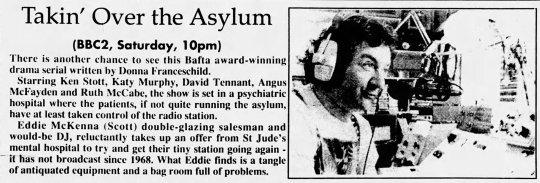
from the Sutton Coldfield Observer · Friday, July 12, 1996
Did you know the series also ran in Canada in March of 1997, and in the US in October 2000 on BBC America?
That's cool enough, but it was the other thing which really piqued my interest. It was something really weird.


Did you know there were once plans to remake Takin' Over The Asylum into a major Hollywood movie? Well, I sure didn't! But it certainly appears to be true.
By late October 1997, MGM Studios announced they had purchased the rights to make the film. They renamed it Fool On The Hill and plans were made for filming to begin in April of 1998.
In this interesting interview in early 1998, David talked about the possible film. He said he would have played Campbell again "like a shot" if they'd offered it to him, and he thought if they did it right, it "could be a fantastic movie." But he wasn't considered.


So who WAS rumored to be cast? Oh, boy.
Jim Carrey as Ready Eddie.
Julia Ormond was being considered as Francine.
.......and, um....Kevin Spacey as....um....who knows?
I say "who knows" because - in true Hollywood style - they started messing with the script. They rewrote it and rewrote it, moving it to an American setting. In this version, the main character remained fairly true to the original, as he was a window and aluminum siding salesman. However, in this rewrite, he isn't our familiar has-been radio DJ, but merely has a passion for radio. This fellow somehow discovers a defunct radio station in a small town mental institution and starts his own broadcasts, in the process "transforming the lives of the institution’s patients as well as those of the town’s more ordinary residents."
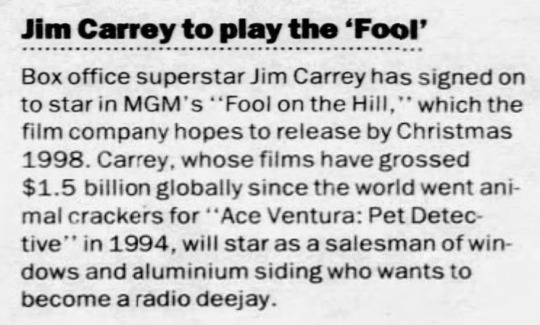
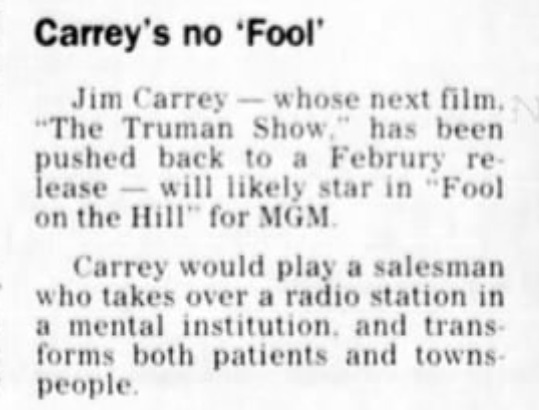
These rewrites apparently took so much time they caused delays in the filming schedule, so they ended up unable to start filming in April 1998. And by the time it was ready, Carrey wasn't available. So it sat on a desk.
Now if you'll recall, I mentioned David had been interviewed about the possible movie project in 1998. At that time, David said Campbell had been rewritten as a "black kid from the ghetto" (THEIR words, not mine). And - of course - David said he was not that character.
In 2001 - when they announced Spacey's possible casting - it appears the script must have been rewritten even more. Because here's the thing. In the 2001 version of the script, Spacey was supposed to be "a hospital administration officer who befriends the new 'inmate' in a bid to bring laughter to his patients." Which isn't at all what David has said in the 1998 interview.
To be fair, all of these descriptions are a bit unclear to me. They don't name the character who Spacey was supposed to play. So if Spacey was supposed to be hospital administration, was he a new character in addition to whoever played Campbell, or was Spacey supposed to replace Campbell? If the former, so be it....but if it was the latter I give out a hearty WTF and a double helping of ewwwww. That means Campbell's character had either been written out of the script or had been relegated to a less important role. And can you imagine any version of Takin' Over The Asylum without Campbell?
Luckily all of this became a moot point because due to a myriad of issues the the film never got made. My personal opinion is THANK THE HEAVENS. It would've been a disaster, right? An absolute stinker. Because the only proper Takin' Over The Asylum is our Takin' Over The Asylum. With Campbell!
Also, you all do know that Takin' Over The Asylum's original working title was Making Waves, right? It sure was! When I interviewed David Blair, the director of Takin' Over The Asylum, he told me so. Here's more proof:

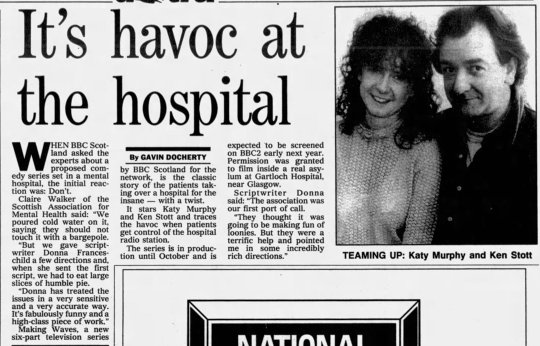
I should point out the filming dates listed in the first blurb aren't completely correct. While I've no idea when filming started, Mr. Blair's given me a photo of the clapperboard for the last day of filming (which I won't publish, as he hasn't given his permission.) The clapperboard reads 29 October 1993.
Anyway, it's really cool that - even after years of doing research, it's fun and ridiculous and remarkable to learn things that are news to me. It's one of the most exciting things about doing this research!
23 notes
·
View notes
Text
Alex Turner’s Interview with Rockin’ On Magazine, October Issue 2022
Written by Shino Kokawa
‘The Car’, a new album with an immersive, slow-burn pleasure that makes you lose track of time when you listen to it. I think it’s tremendously well thought out in terms of both detail and spatial design, but it’s an album aimed at a more organic sound compared to ‘Tranquility Base Hotel & Casino’, which was probably equally well thought out, wasn’t it?
Every single thing you just said, every single thing you just said is great. Thank you very much (laughs). So, first of all, I think this one is definitely influenced by the previous one. I think every piece of work that you did before it plays some kind of rehearsal role for the next one. I think it's absolutely true that this work is more organic than the last one. For example, there is self-expression in the lyrics, and the sound is music that comes straight from my inner self. The first song, which is the introduction to the album, started with a melody that suddenly came to me at one point, and it influenced the whole vibe of the album and everything I wrote later on. So you can hear something melancholy from this first track, and I think you can hear it throughout the whole album, here and there. But it's not like we decided, ‘Okay, this time we’re going to make something melancholy’. It just came out of me, organically, by accident, and you can hear it on the album. It’s an emotional thing that came naturally from within. With this album, we had time to really focus on the details, and we were able to explore dynamics that we’d never done before as a band, paying more attention to detail than ever before.
You described this album as a ‘return to Earth’ from the lunar world of the previous album.
(Laughs). Yes, it is. But to be honest, it’s not actually that simple, I think there are still lyrics on this album that have a sci-fi element to them, and I think there are parts that overlap with the last album. I think we’re trying to move away from that and get closer to Earth, but we haven’t completely come back to Earth yet. (Laughs).
Can you tell us about the starting point for this album, as fragmentary information had come up that Arctic Monkeys were starting to work on a new album around the summer of 2021?
The starting point is 2019, when we went to South America before the end of the tour for the last album, we wrote a song. That song was the starting point for the whole album. It just didn’t make it on this album. We were going to record it until the very end, and we were also going to make it the last song on the album, but we didn’t get into it in the end. However, you can hear the influence of that song from all the songs, and it’s like the song that ties everything together. That song is definitely the starting point for this album, and we’re definitely going to release it at some point.
What kind of song was it? The one with you playing the piano by yourself?
Yeah, yeah. There are a few songs on this album that I wrote on guitar. For example, ‘The Car’, and ‘Mr. Schwartz’. But basically I wrote them on piano. I wrote it by myself first, recorded a demo, then everyone listened to it, and then we got together in the studio and made the finished version.
There were photos online of you recording at Butley Priory, a Suffolk monastery, in the summer of 2021.
Yes, we worked alone for a while in 2020, and then we recorded in earnest as a band at that place last summer.
Did you have a definite theme or concept for the album at that point?
Yes, we did. I think we finally had a pretty clear idea of what the album was going to be about at that point. I don’t know, working with the band in Suffolk was like making a film. It was like shooting a film and then waiting for the editing process. With a film, depending on the editing process, the finished version can be completely different, but with this album, depending on the editing process, it could have gone in a completely different direction that I hadn’t anticipated. So when we all got together to record it, it was a process of just hammering into that sound that was in front of us, and then in the editing process, we would change the direction of the songs to the final finished form.
Was it a process with new musicians joining in and fleshing out the songs as you moved from one studio to another between Suffolk, London and Paris?
First we did it in Suffolk, then we went to La Frette outside Paris to record the vocals. And finally, we did the mixing in London. We also recorded the strings in London. This album was recorded one at a time, rather than all of us getting together and recording live. The whole thing was built up from the individual pieces that each of us created piece by piece. It was the most meticulous work I've ever done. In other words, it was a way of replacing what I had pre-recorded with each of us. What we wanted to do was get the whole band together at Butley Priory and use the energy that you feel in that place and the energy that comes from the band to gather the materials. The Rolling Stones and Led Zeppelin had recorded at that place, and I thought it was similar to what we were working on.
As a long-time fan of yours, I’m pleased to see that this album features a lot of terrifyingly cool guitars. What motivated you to turn to guitars again on this album?
There were things that happened that I didn’t expect, like the distorted guitar sound at the end of ‘Body Paint’, which I didn’t expect at all. But when we got together and played it, that kind of energy, I mean the energy of being with the band again, it just suddenly sounded like that. When we got together as a band, suddenly I wanted to stand up with my guitar in my hand, and I thought, I shouldn’t be sitting at the piano and hiding. So the guitar sound on the album came from the excitement of being with my bandmates again. When I got back in the band, I think it just kind of dawned on me that I wanted to show people my guitar. That happened when we were recording at Butley Priory. As I said before, the recording there was done in the first place with the aim of collecting things that came from the energy of the band being together. So for me, it was that guitar sound.
The arpeggio on ‘Mr. Schwartz’ is really beautiful.
As for the arpeggios, I don’t think I’ve ever played a guitar like that before. I did a bit of picking when I did the music for the film Submarine, but then I thought, it’s time for me to pluck the strings with my fingers on an Arctic Monkeys record. So the arpeggio was an idea that came from that. Actually, when we all started working on it in 2019, I already had the idea of making it a guitar album, and I thought it would be a good idea. But I just couldn’t get to a place where we could get the same guitar sound that we used to play. However, I think there are moments in this record where the guitars sound like what we used to play in the past. It’s not like it’s ringing all the time, but at certain moments it shines.
What kind of challenges did Arctic Monkeys set for themselves with this album, as a guitar band, as opposed to the guitars of the past?
What I thought was important here was the dynamics. I wanted the guitars to feel like they were moving around in the whole piece. There’s quite a lot of guitar usage on this album, but it’s much more subdued than ever before, and I also wanted to experiment with some effects on this album that I hadn’t really used in the past. For example, this time I brought out a wah pedal and blew the dust off it (laughs). The thought of having that kind of sound again itself was very exciting.
By the way, who were your guitar guru artists on this album?
‘Body Paint’ was definitely aimed at a Mick Ronson-esque guitar. I think that’s pretty obvious. And then, hmm, when it comes to influences, I'm thinking of other things (long pause), but, um, that’s about all I can think of right now. More influences were, as I said before, finding the effects again this time, and the wah-wah sound seemed to be very funny (laughs). That alone made me smile. I think those things had an effect.
On the other hand, the cinematic sound from the previous album is still present. From Scott Walker and Burt Bacharach-esque orchestral pop to Morricone and Nino Rota.
Yes.
Even something reminiscent of John Barry again. In your last album, you cited Dion’s Born To Be With You as an inspiration.
Yes. I was actually listening to that album again this morning. I’ve been listening to the film composers you just mentioned for a really long time, and I still enjoy listening to them so much that I think I’ve already absorbed so much of it that it’s almost become part of my DNA to the point where I can’t really draw a line as an objective influence. So when I write songs, I think it comes out naturally. But the difference is that in the end, what we do is just pop music. So in other words, it’s completed through that filter. The composers that you just mentioned don’t make pop music, and that’s what makes me think they are very different.
What is exciting about this album is that the ‘layers’ created by the minimal band sound and the ‘layers’ created by the extravagant orchestra are suddenly swapped up and down, and their strengths and weaknesses are reversed at the drop of a hat. These two layers are reminiscent of the relationship between dialogue and voice-over in film, for example.
I like the idea of voice-overs, I’ll use that next time when I'm a journalist (laughs). Yeah, but what you just said was definitely the intention and I thought it was the only way the album could work. So when a wave comes, we embrace it, and like a wave, each part comes and goes, each part has its place. I wasn’t interested in the typical rock band with strings (laughs). In a way, I think that's even a little bit unrealistic. But I thought the idea of a “rock band” appearing and disappearing was possible. That’s why I sometimes look at rock bands from a bird’s eye view. I think this album is only possible with that kind of agreement, and it actually took me a long time to figure out how to make it work. In other words, at the mixing stage, depending on the ...... time, I tried not to show myself. Sometimes I pulled myself back, sometimes I turned myself off, sometimes I let go and tried not to hold on to what I was thinking or what ideas I had when I was recording. If you hold on to what you were thinking at the time, you might think that you absolutely have to keep this part. In other words, this time, I decided that if I thought something didn't fit into the overall picture, I would delete it, no matter what thoughts were put into it, and I think I was able to do that well. Not only the rock band elements, but also the string section, we recorded something so epic that normally I would have wanted to leave it as it was, but I deleted everything that I didn’t think would fit. So the most important thing about this album was that the overall balance was paramount above all else.
Earlier, you mentioned that there are still sci-fi elements in the lyrics. Nevertheless, the lyrics of this album have come down to earth. For example, “Lunching with an English tourist” and “Opening a mini champagne bottle” described a holiday at a seaside resort somewhere, or scenes from a journey.
“The Car” is certainly like that. And “I Ain't Quite Where I Think I Am” has an island in it. So I think you could say that there’s a European feel to it, but what I'm trying to say there is that I know where I am. I know where I am. And I think that's what you see in a lot of parts on this album. I think one of the things that the lyrics on this album talk about is the passage of a tremendous amount of time. And that leads to a feeling of “So where am I now?”, which led to the description of places. I just performed at Reading Festival a few weeks ago, and it reminded me of the first time I performed in Reading. I think I was 19 or 20 or something. I felt really nostalgic and I was extremely excited when I actually got on stage. And when I did the maths, it had been 17 years since the moment I first performed. It was very hard to accept that fact. I thought, “No way, that can't be true, that can't be true” (laughs). Yeah, I think the lyrics on this album express that feeling in some ways.
Does it mean melancholy about the past? Or is it about looking at it objectively?
There may be lyrics about the past, but the music doesn’t look back. The music as a whole feels like it’s about moving forward. So it’s a contradictory relationship, and it’s kind of balanced in that way.
Nevertheless, the vocal excellence of this album is impressive. You said in the press release that you “channeled the expression of emotions so deep that sometimes the words almost seem to get in the way” - does that mean that the lyrical content of this album is not that relevant to the vocalisation?
Oh ...... it’s ...... (long pause), I think it all has to work together to become something that strikes a chord with ...... people. It’s not just the vocals, it’s the song. Not just the vocals, but the song, the melody, the chords, the lyrics. Singers often talk about how their voice comes from their soul, from their instincts. In other words, you don’t sing from your head, you want to sing from here (pointing to the belly). But actually, it’s sometimes difficult to reach my instinctive voice. ...... I used to remember Leon Russell’s wonderful song “A Song for You”, where he sings, “If my words don’t come together / Listen to the melody / Cause my love is in there hiding.” That's the lyric I thought about. That alone is a very clever expression (laughs), and it sums up all I wanted to say. I mean, what I’m trying to express here is in something that goes beyond words.
How do you think your vocals on this album were able to embody such deep emotion, even beyond words?
I just have to trust my instincts. And maybe accepting how I’m feeling in this moment. I tried to connect to that. I think that’s something that gradually increases over time, and then, physically, growing up [laughs]. I’ve been thinking about that over time. In fact, compared to when I was 18, my voice is definitely a bit lower. I really feel that now. I didn’t realize that my voice had changed over time, but now when I get on stage and try to sing my first songs or my old songs, I feel like my voice back then was so high that I would really get out of breath (laughs).
What is the album title ‘The Car’ a metaphor for? I heard that it was inspired by a photograph that Matt Helders took. When I saw that picture, I had the feeling that something was about to start, like the first scene in the film.
Yeah, that's exactly right. When I saw that photo, I was really excited too. It was taken by Matt, our drummer, and it was taken long before the new songs were written, and as soon as I saw it, I thought, ‘Something's about to start’ (laughs). Then I also thought that the photo definitely had to be named as ‘The Car’. That was the beginning of everything. Of course, I wanted to shorten the title of this album after the previous one (laughs). So it was perfect. But I just thought it would be nice because the title doesn’t symbolize anything about the whole record, it's not really connected to it, it’s rather uncluttered.
Arctic Monkeys celebrates their 20th anniversary this year. What do you think, is the 20-year history of Arctic Monkeys something that is a natural projection of your lives?
No, seriously, it’s really been 20 years since we all got together in the summer of 2002 in a garage and met everybody. So I think there’s definitely a sense of looking back on that somewhere on the album, but it’s not directly about ‘we’ve been together 20 years now’ (laughs), but there are some musical elements where we kind of come to terms with that.
Is the last 20 years a personal story of the four of you growing up? Or did you feel like you were running a huge project called Arctic Monkeys?
Probably a bit of both, I suppose. Yeah, but it's interesting. I know what you mean. The relationship between the four of us is something that goes back to our childhood, before the band started, before the name Arctic Monkeys, before the concept of a band. Our growth story is definitely part of the band’s growth story, but at a certain point we had to separate the two. At some point, I had to separate the concept of the band “Arctic Monkeys” and the relationship between me and my friends. By the time we get here, we’re already a family, so it’s not just Arctic Monkeys. I may not have explained it well.
The band has a series of upcoming tours, but the Japanese fans have been waiting for the show in Japan for a long time!
I definitely want to go, because I feel like I haven’t been to Japan for a very long time. When was the last time I went there? I can’t even remember. But I definitely want to go this time. I'm planning for that now.
#interview#transtlation#arctic monkeys#alex turner#the car era#rockin' on 2022#it's basically translated by deepl and i just made a few modifications to make it more smooth#so the full text won't be 100% accurate and please feel free to correct it if you guys know japanese#all the recent interviews of this era are just so good#here we get more information about that important song that didn't make it into the album#his thoughts about the relationship between lyrics and vocals and the idea of band appearing and disappearing are also interesting to read#and about the last part... where is the asian tour announcement then?
151 notes
·
View notes
Text

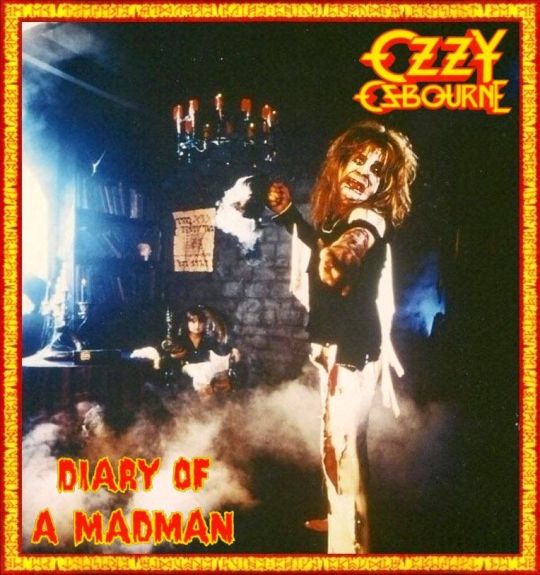
Nov 7th 1981 #OzzyOsbourne released the GREAT album "Diary Of A Madman" #OverTheMountain #FlyingHighAgain #YouCantKillRockAndRoll #Tonight #HeavyMetal
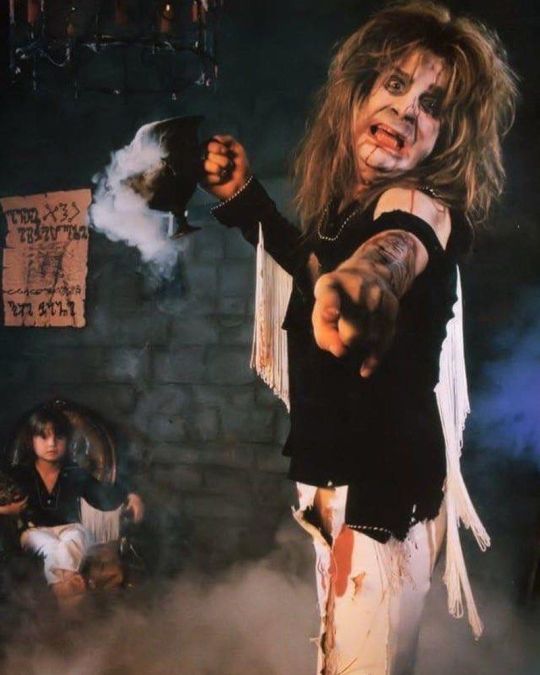
The album's cover art features Osbourne's son Louis to his side, with Osbourne himself posing in theatrical make-up

Diary of a Madman is the second studio album by English heavy metal vocalist Ozzy Osbourne. It was released in October 1981, and re-issued on CD on 22 August 1995. This is the last Osbourne studio album to feature guitarist Randy Rhoads and drummer Lee Kerslake. An altered version appeared in 2002 with the original bass and drum parts removed and re-recorded. In 2011, a Deluxe 30th Anniversary Edition was released with all original parts restored. To date, the album has sold over 3 million copies worldwide

Diary of a Madman was supported by the Diary of a Madman Tour, which began on November 5, 1981, and ended August 8, 1982, spanning Europe, North America, and Asia. On March 19, 1982, during the North American leg of the tour, Rhoads died in a plane crash in Leesburg, Florida; after a two-week break, the tour continued with guitarist Bernie Tormé performing several shows in place of Rhoads before in turn being replaced by Brad Gillis.

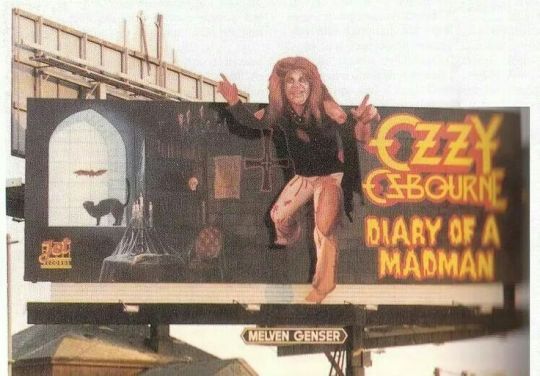
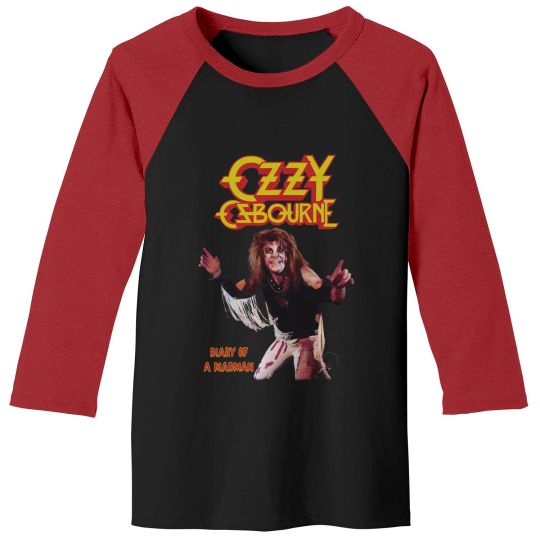

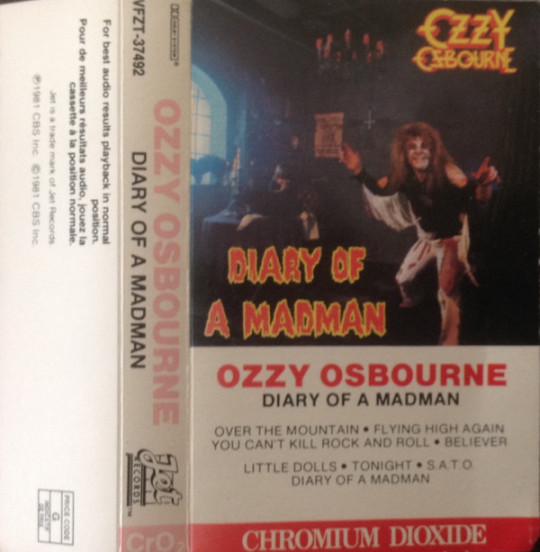
#thisdayinmetal#ozzy osborne#diary of a madman#album release#randy rhoads#heavy metal#rudy sarzo#tommy aldridge#brad gillis
15 notes
·
View notes
Text
After some very cursory googling I have decided that family video had a copy of the original English dub of Nausicaa of the valley of the wind. (Which was apparently not very good because of how it was edited down and translated, and also called "Warriors of the wind" apparently my dad saw it in theaters when it first came to America with his mom- anyway)
Family video has a copy and Robin sees foreign film with a female protagonist and environmentalist message, and Eddie sees Japanese animated film with a cool fantasy-ish title and they decide to watch it for movie night and they LOVE it. Steve loves the ohmu even though they're scary and the little fox-squirrel (the ewoks were his favorite part of star wars). Robin like I was as a child is a little in love with Nausicaa and also has a crush on the very intense lady in the armor. Eddie wants to make a campaign about it.
Anyway the party gets really into studio Ghibli movies and tries to get copies and/or see theatrical releases of every English sub and dub they can.
I think Eddie's favorite is spirited away. Robin loves princess Mononoke. Steve loves all of them but especially Totoro (because he loves a fuzzy little guy) and whisper of the heart weirdly enough.
Dustin loves Laputa Castle in the Sky because of the big robot guys. Eleven loves Kiki's delivery service. Will has a crush on Howl but also loves Spirited Away. Mike says Spirited Away is his favorite (because will and Eddie like it) but cannot make it through Totoro without crying.
Nancy didn't like the original dub of Nausicaa that much but the full version is her favorite (second to princess Mononoke). Argyle also likes Nausicaa but mainly because of the plants/forest, and Totoro because he wants nothing more than to hug a Totoro. Jonathan likes Totoro because of the Mae and Satsuki's relationship.
Hopper likes porco Rosso even though he says they're all weird. Joyce loves kiki even though shes appalled that Kiki's parents let her just. Leave that young. She also loves Ponyo when it comes out.
Murray only likes the cat returns.
Please tell me what you think their favorite ghibli movies are/if you agree.
#stranger things#stranger things headcanons#stufio ghibli#ghibli movies#this is also steddie#because all my st posts are steddie.
10 notes
·
View notes
Text

@yulsbabymama
WEEEEEEEEEEEEELL...
☝️🤓 the black parade is...
The Black Parade is the third studio album byAmerican rock band My Chemical Romance . Released in Europe on October 23, 2006 and in the United States on October 24, 2006, [ 1 ] by Reprise Records , it was produced by the band in partnership with Rob Cavallo , known for having produced several albums for the Goo Goo Dolls and Green Day . It is a rock opera and conceptual album centered on a character who is close to death from cancer known as "The Patient". The album tells the story of his apparent death, afterlife experiences and reflections on his life. It is the band's only studio album to feature Bob Bryar on drums before his departure in 2010.
The Black Parade received generally favorable reviews from critics , and the band achieved their first UK number-one single with " Welcome to the Black Parade ". The album debuted at number two on both the Billboard 200 and the UK Albums Chart and is also certified triple platinum in the United States by the Recording Industry Association of America (RIAA) and in the United Kingdom by the British Phonographic Industry (BPI) , in addition to certifications of gold in Argentina by the Argentine Chamber of Phonogram and Videogram Producers (CAPIF) and in Chile by the International Federation of the Phonographic Industry . The Black Parade received the Platinum Europe Award from the International Federation of the Phonographic Industry for one million sales in Europe. The limited edition box set also earned My Chemical Romance a nomination at the 2008 Grammy Awards . Four singles were released from the album: " Welcome to the Black Parade ", " Famous Last Words ", " I Don't Love You ", and " Teenagers ".
My Chemical Romance kicked off The Black Parade World Tour on February 22, 2007, at the Verizon Wireless Arena in Manchester, New Hampshire . The tour included 138 performances around the world, as well as several festivals and shorter shows. The tour was the longest and most internationally wide-ranging tour the band has done as a headliner, with three legs in North America , two in Europe and one in Asia , Oceania and Latin America .
The song "Dead!" appears in the Xbox 360 game console version of the game Guitar Hero II , and the three songs "Teenagers", "Famous Last Words", and "This Is How I Disappear" were available as downloadable content. As of 2016, The Black Parade has sold three million copies in the United States and four million worldwide. The album was re-released as The Black Parade/Living with Ghosts on September 23, 2016, in celebration of the tenth anniversary of the album's release. In 2020, Rolling Stone magazine ranked the album number 361 on its updated "500 Greatest Albums of All Time" list. [ two ]
8 notes
·
View notes
Note
The Black Parade is the third studio album by American rock band My Chemical Romance. Released in Europe on October 23, 2006, and the United States on October 24, 2006,[1] through Reprise Records, it was produced by the band with Rob Cavallo, known for having produced multiple albums for the Goo Goo Dolls and Green Day. It is a rock opera and concept album centered on a dying man with cancer known as "The Patient". The album tells the story of his apparent death, experiences in the afterlife, and subsequent reflections on his life. It is the band's only studio album to feature Bob Bryar on drums before his departure in 2010.
The Black Parade received generally favorable reviews from critics, and the band achieved its first number one single in the United Kingdom with "Welcome to the Black Parade". The album debuted at number two on both the Billboard 200 and the UK Albums Chart and is also certified as triple-platinum in the United States by the Recording Industry Association of America (RIAA) and the United Kingdom by the British Phonographic Industry (BPI), as well as with gold certifications in both Argentina by the Argentine Chamber of Phonograms and Videograms Producers (CAPIF) and Chile by the International Federation of the Phonographic Industry Chile. The Black Parade was given the Platinum Europe Award by the International Federation of the Phonographic Industry for one million sales in Europe. The limited edition boxed set also earned My Chemical Romance a nomination at the 2008 Grammy Awards. Four singles were released from the album: "Welcome to the Black Parade", "Famous Last Words", "I Don't Love You", and "Teenagers".
My Chemical Romance began The Black Parade World Tour on February 22, 2007, in the Verizon Wireless Arena in Manchester, New Hampshire. The tour featured 138 performances worldwide, as well as several festival and condensed shows. The tour was the longest and most internationally comprehensive headlining tour the band played, featuring three legs in North America, two legs in Europe, and one in Asia, Australia, and Latin America.
The song "Dead!" appears in the Xbox 360 version of Guitar Hero II, and the three songs "Teenagers," "Famous Last Words" and "This Is How I Disappear" were once available as downloadable content. The Black Parade has sold three million copies in the United States as of 2016, and four million worldwide. The record was reissued as The Black Parade/Living with Ghosts on September 23, 2016, in celebration of the tenth anniversary of the album's release. In 2020, Rolling Stone ranked the album number 361 in their updated "500 Greatest Albums of All Time" list.[2]
Three Cheers for Sweet Revenge (often shortened to Three Cheers or Revenge)[1] is the second studio album by American rock band My Chemical Romance, released on June 8, 2004 by Reprise Records.[2][3] With this album, the band produced a cleaner sound than that of their 2002 debut I Brought You My Bullets, You Brought Me Your Love.[4] It was the band's first release to feature rhythm guitarist Frank Iero on all tracks, as well as the final release to feature drummer Matt Pelissier, who would later be replaced by Bob Bryar.[5]
The album was a success for both the band and the label.[6] The record produced four singles—"I'm Not Okay (I Promise)", "Helena", "The Ghost of You", and in the United Kingdom, "Thank You for the Venom".[4] It was certified platinum by the Recording Industry Association of America (RIAA) less than a year after its release,[3] and has sold over three million copies in the United States.[6]
Musically, Three Cheers for Sweet Revenge has been described as emo,[7][8] alternative rock,[8] pop punk,[9] post-hardcore,[10] punk rock,[11] and pop rock.[12] While I Brought You My Bullets, You Brought Me Your Love was considered "a particularly strident entry in that shifty genre of bands tortuously slamming together elements of emo, hardcore, and even metal",[13] Three Cheers for Sweet Revenge "both showcased their songwriting skills and gave them much-deserved attention".[4] Moving away from the "screamo parts"[14] and "the more complicated structures"[15] of their first record in favor of a sound that "skirts the line between pop punk and edgy, theatrical, emo"[4] while being "strongly influenced by hardcore punk",[15] Three Cheers for Sweet Revenge has been variously compared to The Misfits,[16] AFI,[13] and Thursday.[13]
Lead singer Gerard Way has referred to the first single "I'm Not Okay (I Promise)" as a "self help pop song"[17] while also being called "a surging piece of emo-pop with a hook as ridiculously catchy as it was ridiculous"[18] and a "moving anthem for the young and depressed"[19] by AllMusic and Rolling Stone respectively. This single went on to be nominated for the Kerrang! award for best single[20] and reached number 86 on the US Billboard Hot 100.[21]
The album opener "Helena" has been referred to as an "album highlight and smash hit". Gerard has claimed that the song "shaped what the album is about" and "revealed their dark side" in comparison to the first single.[17] Its lyrics mourn the loss of Gerard and Mikey's grandmother,[17] Elena Lee Rush, and was their first entry into the top 40.[21]
9 notes
·
View notes
Text
“Thor: Love and Thunder” Promised Us Gay Valkyrie, So What Happened Here?
Marvel keeps getting away with this!
There was no excuse that in 2017, the morning after flirtation between Valkyrie and another woman was edited out before Ragnarok’s release or that the death of her supposed greatest love was left as a question mark, only to be clarified in a movie five years later.
There was no excuse that in 2018 a quietly queer flirtatious moment in Black Panther, reportedly between Okoye and Ayo, met the same erased fate. It was nearly laughable in 2019 when the first queer canon character finally came to the MCU, it was a glorified extra role in the early minutes of Avengers: Endgame (their 22nd film!) that could have easily been removed from the plot with no consequence.
Chloé Zhao’s Eternals in 2021 brought Marvel’s first same-sex kiss, which coincidentally could also be easily cut with no notice if necessary, Brian Tyree Henry’s excellent work as Phastos notwithstanding. 2021 also came with Loki coming out as bisexual, but in a single throwaway line during the third episode of his television show.
Earlier this year, in 2022, Doctor Strange and the Multiverse of Madness’ America Chavez, a famously lesbian Latina superhero in the comics, had her queerness reduced to a small Pride pin on denim jacket and a less than 20 second scene with her lesbian mothers, which again — are you picking up the theme here? — could have been cut without changing anything in the script! Disney of course, did not cut it, and if they wanted a pat on the back for their “brave” choice, look at that — I’m fresh out of participation trophies.
Now we’re full circle back to Valkyrie, who’s big anticipated queer reckoning — after her first cutting room floor incident — was merely a mention of an off-camera and dead girlfriend. Here we are again.
We deserve more than this. If skipping a single scene is all it would take to erase someone’s queerness for an audience, then it is not enough. We deserve more than “blink-and-you-miss-it” representation, or to pretend that representation is good — when we know it’s not! — because we’re scared that if we ask major studios for more, it will be taken away altogether. We deserve real storytelling, not crumbs. Even among Gods of thunder, perhaps especially then.
Ultimately, in a movie that promises love to span each universe, nearly everyone finds some version of a love-filled ending, except the sole queer woman of color. Even Korg — yes, the cheerful Rock monster dude! — finds gay happiness to call his own. Funny how the Black bisexual woman can’t say the same, now isn’t it?
[Source]
#Thor#Valkyrie#Thor love and thunder#Thor love and thunder spoilers#queer#bisexual#queer representation#mcu salt#mcu critical
165 notes
·
View notes
Text
Marvel vs. Capcom 2: New Age of Heroes

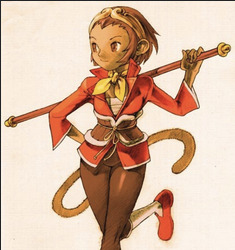


Date: February 24, 2000
Platform: PlayStation 2 / Xbox / Dreamcast / Arcade / Xbox 360 Games Store / PlayStation Network (PS3) / iPhone / iPad
Developer: Capcom / Capcom Production Studio 1 / Backbone Entertainment
Publisher: Capcom
Genre: Fighting
Theme: Fantasy / Martial Arts / Superhero / Comic Book
Franchises: Marvel vs. Capcom / Capcom Versus / Marvel / Street Fighter X All Capcom / SNK vs. Capcom: Card Fighters DS / SNK vs. Capcom: Card Fighter's Clash 2 Expand Edition
Also known as: MVC2
Type: Reimanging
Summary:
Marvel vs. Capcom 2: New Age of Heroes is a 2D tag-team fighting game developed and released by Capcom for the arcades (running the Dreamcast-based Sega NAOMI hardware) on February 24, 2000.
The fourth installment of the Marvel vs. Capcom crossover series, the game doubles the roster of its predecessor (including new additions and returning fighters) while adding new 3-on-3 gameplay and simplified controls (two punch buttons, two kick buttons, and two assist buttons). It also brings back the classic "assist attack" system (sans "partners") while adding a new "snapback" attack (a close-ranged attack that, if hit successfully, swaps the opponent's character with another). A unique aspect of the game is its use of experience points for each arcade machine that increments by playtime, determining how many characters and alternate costumes are unlocked.
One of Capcom's earliest fighting games developed outside of their arcade hardware, Marvel vs. Capcom 2 combines 2D hand-drawn sprites with 3D backgrounds (a style later used for Capcom vs. SNK 2: Mark of the Millennium). It is the last game in the series to use hand-drawn sprites for its characters.
The game was later released for the Dreamcast throughout 2000 (March in Japan, June in North America, and July in Europe), adding a new system of "purchasing" the locked characters/costumes with accumulated playtime (and trading them using the VMU). The Japanese version of the game also includes online multiplayer and the ability to use VMUs with the arcade version (where players can use their unlocked characters and earn experience points). It was later ported to the PlayStation 2 (in September 2002, with the Japanese version including online multiplayer) and Xbox (in September 2002 for Japan and March 2003 for North America).
It was later ported (by Backbone) as a digital release for the Xbox 360 (via Xbox Live Arcade on July 29, 2009) and the PlayStation 3 (via PlayStation Network on August 13, 2009). This version includes online multiplayer (including a six-player lobby system), various graphical options (including widescreen support), support for custom soundtracks, and all content unlocked from the start. The original console version was ported to iOS devices on April 25, 2012 (adding touch controls). These ports were removed from their respective storefronts on December 2013.
Source: https://www.giantbomb.com/marvel-vs-capcom-2-new-age-of-heroes/3030-2612/
Link: https://www.youtube.com/watch?v=tW1FA2AFAzI
#Marvel vs. Capcom 2: New Age of Heroes#Marvel vs. Capcom#Capcom Versus#Street Fighter X All Capcom#SNK vs. Capcom: Card Fighters DS#Marvel#SNK vs. Capcom: Card Fighter's Clash 2 Expand Edition#jttw media#jttw game#video game#game#reimaging#reimagining#continuation#sonson#son goku#sun wukong cameo#sun wukong
5 notes
·
View notes
Text
I have a theory
about Kwazii's backstory.
This one is a bit of a stretch so buckle up kiddos.
SO: who is our favourite orange, boot wearing, adventure loving cat?

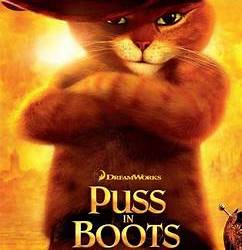
You thinking what im thinking?
[Edit:] I found these photos after i posted this but i think it's pretty important] He has a sword. This is from the Sword fish creature report.

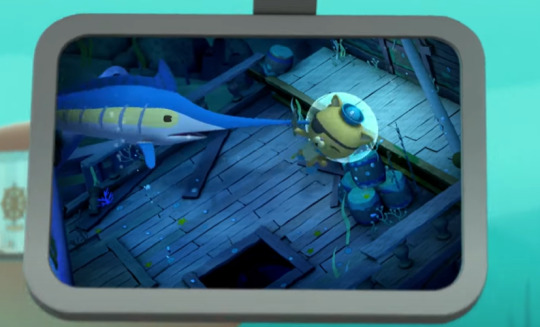
Backstory about Puss in Boots: (from wikipedia) "Puss in Boots" (Italian: Il gatto con gli stivali) is an Italian fairy tale, later spread throughout the rest of Europe, about an anthropomorphic cat who uses trickery and deceit to gain power, wealth, and the hand of a princess in marriage for his penniless and low-born master.
The first written account of this tale is from 1550 by Italian author Giovanni Francesco Straparola, who included it in his The Facetious Nights of Straparola. Other texts were published in 1634 and 1697.
If you look at these dates carefully, you may see that they line up pretty well with the Golden Age of Piracy:

Coincidence? I don't think it's a coincidence that a story about a sword wielding, thieving cat would be very similar to the acts of real-life pirates.
Puss in Boots originated in Italy, although it has been translated, adapted changed to fit themes in Asia, Africa and South America.
Here is a little trivia about Kwazii:

It's hinted that he is from somewhere in East or Southeast Asia, although it's largely been irrelevant to the franchise.
In the Philippines version of Puss in Boots; - ...the helpful animal is a monkey "in all Philippine variants", according to Damiana Eugenio -(Wikipedia)
A monkey? Did you mean:

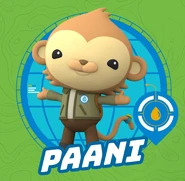
Paani?
Who is from India.


And India is in Asia. Specifically South Asia. Next to Southeast Asia.
Hmmmmmm. Still a coincidence? I still have more evidence.
(From Wikipedia) - It was also adapted by Toei as anime feature film in 1969, It followed by two sequels. Hayao Miyazaki made manga series as a promotional tie-in for the film. The title character, Pero, named after Perrault, has since then become the mascot of Toei Animation, with his face appearing in the studio's logo.

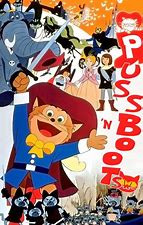
Hmm, an orange cat, from Japan, based off the story of Puss in Boots? Where have I heard that before?
Kwazii...
Another thing. Why I mention Paani is becouse he is very similar to Kwazii. They both have a 'mysterious' past that we dont know much about. (An excerpt from the Octonauts Wiki) - In general, he shares a lot of qualities with Kwazii. Physically, he has a similar pale, light grayish gamboge palette and a long tail. Personality-wise, he seems just as if not more daring, along with being impulsive and rather acrobatic. He even gets stopped by Captain Barnacles before he does something without thinking and runs off before the other characters can catch up with him in a way that intentionally mirrors Kwazii doing the same thing. They also have a shared love for cooking, eating snacks (such as pudding), and telling stories.

You know who else is an orange adventure loving cat?

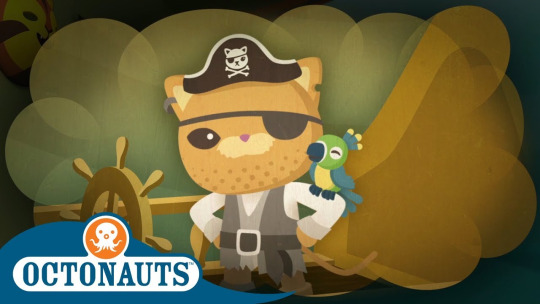
Calico Jack, who is the oldest Octo-agent, Kwazii's grandad, and a pirate. Who wears a funny black hat and boots? (Technically one boot and a peg leg) Who wears a belt and (i think) has a sword?
(Excerpt from the Shrek Wiki) - he [Puss in Boots] is a smooth-talking cat with a Spanish accent, usually wearing a cavalier's hat, a belt with a sword, a small black cape, and small Corinthian boots.
[Edit:] Although the Puss in Boots movie solely starring Puss was released in 2011, that specific adaptation of Puss in Boots first appeared in the 2004 Shrek Movie.

You know what else appeared in 2004 and was released in book form in 2006?

THE OCTONAUTS

Which Brings Me to My Final Conclusion:
I think Kwazii is somehow related to the story of Puss in Boots, whether it be himself, Paani, or Calico Jack.
We dont know enought about Kwazii's past to determine his backstory, or what happened to his parents, (as they are never mentioned). However, i think this might be a decent speculation into Kwazii's Mysterious Pirate past.
And one more thing:
Dont think i forgot that kwazii is based off Meomi's one eyed cat. (From the wiki) - 'Kwazii was based off of Meomi's late one-eyed cat, Eco.' Im gonna make that fit this theory somehow.
Again, this is just a theory, probably isn't true but i love to speculate. Lemme know if you want to see more Octonauts theories.
Sorry for the long post lol <3
#octonauts#octonauts above and beyond#kwazii#calico jack#puss in boots#theories#fan theory#theory#speculation#octonauts paani#coincidence i think not#octonauts theory
75 notes
·
View notes
Text

Erich von Stroheim and Maude George in Foolish Wives (Erich von Stroheim, 1922)
Cast: Erich von Stroheim, Miss DuPont, Maude George, Mae Busch, Rudolph Christians, Dale Fuller, Albert Edmondson, Cesare Gravina, Malvina Polo, C.J. Allen. Screenplay: Erich von Stroheim; titles: Marian Ainslee, Walter Anthony. Cinematography: William H. Daniels, Ben F. Reynolds. Art direction: Richard Day, Elmer Sheehy, Van Alstein. Film editing: Arthur Ripley.
Erich von Stroheim's reach exceeded Hollywood's grasp, though not without some initial encouragement by the studio heads. Universal eagerly promoted Foolish Wives as "the first million-dollar movie," and most of that sum was apparent on screen: the huge sets re-creating Monte Carlo that were built on the Monterey Peninsula in California. Some of it, too, wasn't visible: Stroheim reportedly insisted on having underwear created for his actors bearing the monograms of their characters. But there were limits to what the studio would do for the director: When Rudolph Christians, a key actor in the film, died in mid-filming, Stroheim proposed that his scenes be reshot with his stand-in, Robert Edeson, but was forced to give in to the studio's work-around: Edeson played the role in the remaining scenes with his back to the camera. But mostly, the studio's resistance was to Stroheim's vision of a movie that would run somewhere between six and 10 hours and be shown on two consecutive nights. He was forced to settle for a three-and-a-half-hour version, which was subsequently cut again under the instructions of the New York censors. More cuts by the studio followed after the film was a box office disappointment, so that what we see today is a reconstruction cobbled together from existing versions. But after that, what we have is a juicy, kinky melodrama about decadent Europe trying to corrupt innocent America. Stroheim plays a con man pretending to be an exiled Russian aristocrat, Count Sergius Karamzin, living with two women he says are his cousins: the phony princesses Olga Petchnikoff (Maude George) and Vera Petchnikoff (Mae Busch). They're out to milk whatever cash they can from suckers at Monte Carlo, and Sergius sets his sights on Helen Hughes (Miss DuPont), the wife of an American diplomat (Christians). In his down time from that seduction, he also pursues, with purely carnal intent, a hotel maid (Dale Fuller) and the pretty but mentally challenged daughter (Malvina Polo) of the man who counterfeits the money Sergius uses to bilk gamblers at the casino. There's a spectacular storm and an even more spectacular fire, too, before Sergius gets perhaps more than what's coming to him. Even in its truncated version, Foolish Wives is almost too much.
6 notes
·
View notes
Text
Seven
Release date: 14 July 2023
Announcement
Official page
Promotion Schedule
Concept Photo (see below)
Short Film
BTS (Behind-The-Scenes) Film
Recording Film Preview
Recording Film
Official Performance Video
Performance Video Behind
Dance Practice
Dance Practice Behind
Other versions: Weekday Ver. including the band ver. and the Summer Mix (Visualizer), Weekend Ver. including the Festival Mix (Visualizer), the Island Mix (Visualizer), the Nightfall Mix (Visualizer), and the Lofi Mix (Visualizer), Alesso Remix (Visualizer)
Latto's first and second tweets
Challenge Compilation Video
Fanchant
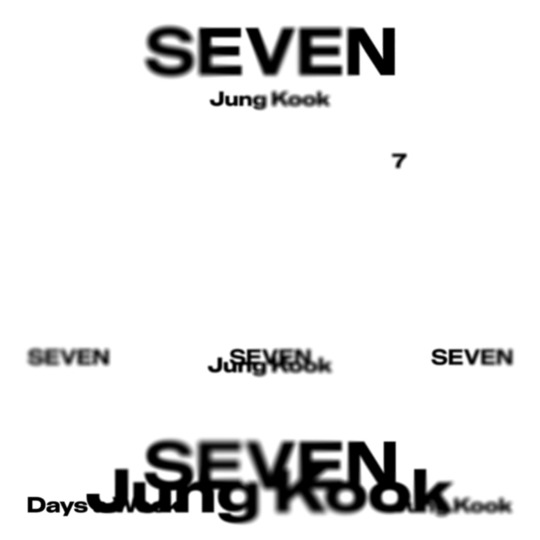
Jung Kook is the sixth member to have a solo release. The invigorating summer song has notably been promoted through posters stuck on several city walls around the world (Bangkok, Chicago, Paris).
Concept Photo
Release date: 6 July 2023
Outfits and accessories
The pictures used for the promotional posters were part of the concept photo.
MV
Release date: 14 July 2023
Teaser
MV Photo Sketch
Episode of the MV Shoot Sketch
Outfits and accessories: tweets of Jung Kook's and Han Sohee's outfits by @BangtanStyling, tweets from theclosetofjk
youtube
The MV was filmed at the Universal Studios Lot in Los Angeles, on the Wall Street backlot (Google Maps). You can find detailed credits for the MV on Jason Baum's Instagram post. Josh Hensley also named several members of the lighting team in his own post.
The other lead character is played by Han So-hee (Wikipedia page).
Wednesday (laundromat)
The clock shows it's 10:05 in the evening.
You can see several signs such as these (#1 src, #2 src, #3 src):

There also seem to be several yellow bottles of Tide laundry detergent.

We see a vending machine at 01:28, which contains snacks such as
Whizzers
Utz chips, both original and salt'n vinegar
Snak Club nuts or candies
Two elements could be nods to the movie Everything Everywhere All At Once:
The "family washers" sign, which is identical
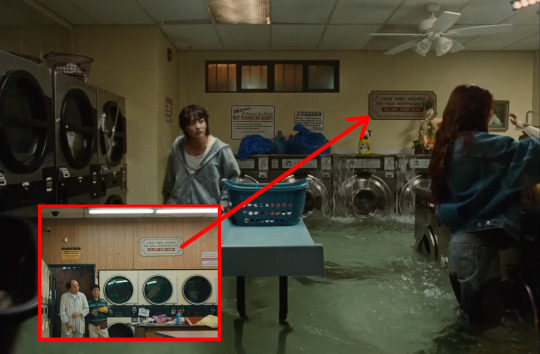
The laundry vending machine, that seems identical (hard to confirm)

A lady dressed as Evelyn (Michelle Yeoh)

There could be references to other media but we don't have as concrete proof as with Everything Everywhere All At Once. People mostly mentioned Titanic (for the flood and the couple staying together, cr.) but Beef (for the similar intro, cr.), as well as Michael Jackson's "The Way You Make Me Feel" (for the man running after the girl and the storm, cr.), were also talked about. There are also theories about each day being a different reference (cr.)
Friday (storm)
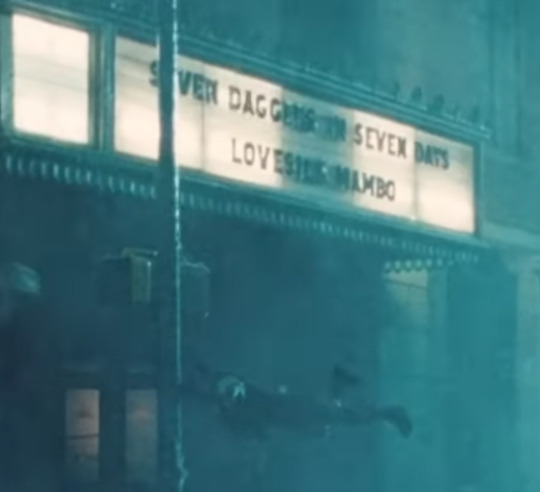
The movies shown at the theater are Seven Daggers in Seven Days and Lovesick Mambo.
Saturday (funeral)
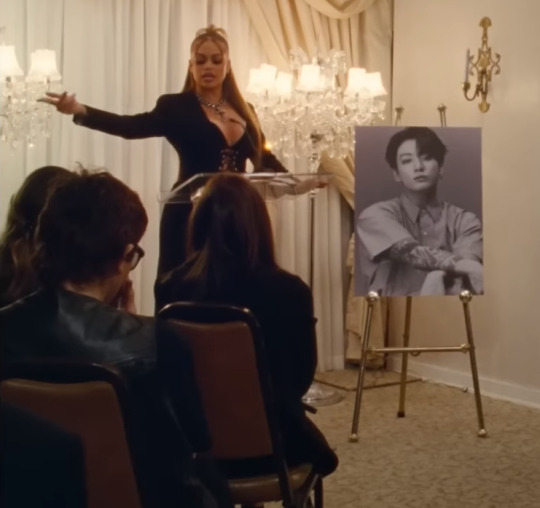
The picture used during Jung Kook's fake funeral is from Proof Collector's Edition.
Interviews, press releases, and promotion
Spotify: Jung Kook’s on a mission to wish ARMY sweet dreams | Spotipoly Game (Behind the Scenes) and Jung Kook dives into a ball pit to answer ARMY’s burning questions | Ball-terview
Weverse Magazine: "Jung Kook: “I’ve been changing a bit”"
Good Morning America: tweets, "Euphoria" performance, "Dynamite" performance, interview, "Seven" performance
Elvis Duran Show: "Jung Kook On "Seven" And Performing On The Moon"
BBC Radio 1: tweets, 'Seven' in the Live Lounge (video on BANGTANTV), 'Let There Be Love' in the Live Lounge (video on BANGTANTV)
Z100 New York: tweets, Jung Kook Explains Why He Thinks Fans Liked Watching Him Sleep
The One Show: 'Seven' Live from London (video on BANGTANTV), Stage CAM
Rolling Stones: "Check out our exclusive images as Jung Kook tells us about solo summer anthem ‘Seven’"
Weverse Magazine: "Jung Kook shatters records with “Seven (feat. Latto)”"
Audacy Check In
230730 Inkigayo: "Seven", encore
Ask Anything Chat
9 notes
·
View notes
Text
A-T-4 042 Art Of Versions
The Art of Noise follow the Into Battle EP with Beat Box. As you've probably guessed from previous ZTT and AON posts releasing many different edits and versions was their m.o. The image (I got at least) was the technology (most noticeably the Fairlight) and time in the studio gave you the ability to churn out endless variations (AON released at least 11 'diversions' of Beat Box). It was great advertising for Trevor Horn as he and his partner owned one of the most sophisticated recording studios on the planet at the time. It's easy to see similarities with Jamaican producers and studios that in the previous decade created dubs and versions, although the closest AON got to producing a riddim would be Moments In Love which has been covered, remixed, and sampled a lot a lot. We have had pop music factory production lines before and I suppose this is where Trevor Horn crosses over with his contemporary Pete Waterman, according to Phil Harding "Waterman watched Trevor Horn so closely that he would strike a deal with equipment suppliers to furnish him with whatever state-of-the-art gadgetry Horn had." Before his hit factory had been established Waterman produced a Relax sound alike track, complete with a look alike sleeve, in 1984 called The Upstroke by Agents Aren't Aeroplanes. Nowadays trap music can be made quickly for very little money and production is more automated and streamlined than it ever has been
Beat Box was the first track AON worked on and it came from JJ Jeczalik messing around with recordings of Yes drummer, Alan White's drums with a Linn drum machine, a Fairlight CMI Series II and Page R (music sequencing software) while Horn was working on the Yes album 90125 (the similarities between the Red + Blue Mix of Owner Of A Lonely Heart and Beat Box are unmistakable). "So JJ was screwing around in the back room and I remember him playing me that 'Beat Box' drum loop and I said 'Jees, that's fantastic, they'll love that in New York.'"
...And they did, Beat Box did very well on the Billboard dance and black music charts in America, reaching number 1 and 10 respectively. Writer Simon Reynold's has written Beat Box was popular with breakdancers in the US, I believe it's still popular with poppin and lockin dads (and granddads)
In June 1984 AON released their debut album Who's Afraid of the Art of Noise? the title a pun on the 1962 play and later film Who's Afraid of Virginia Woolf? which is itself a pun on the song Who's Afraid of the Big Bad Wolf? from the 1933 Walt Disney cartoon The Three Little Pigs... would we call this a meme?
On the album is Close (To The Edit) which would be released as a single in October 1984. There were five different 12" versions of Close (To The Edit) released, including a picture disk. As far as I can tell AON put out six different versions of the track at the time, including the LP version (that's if I ignore the cassette single). To make matters more confusing Close (To The Edit) evolved out of the afore mentioned Beat Box. Beat Box Diversion Two is a version of Close (To The Edit) and vice versa, as are Diversion Seven and Diversion Eight. Close (To The Edit) was named after the Yes album Close To The Edge and they had fun with the names of the various versions of Close (To The Edit) that they put out, Close-Up, Closer, Closest, Closely Closely (Enough's Enough), Closed
Close (To The Edit) features Anne Dudley playing a very familiar sounding walking bass on piano, if we ignore the car ignition sounds they also use a sample of Boogie Woogie Bugle Boy by The Andrews Sisters. I wondering if this comes from the Duck Rock sessions the then unnamed AON did with Malcom McLaren? I'm thinking Buffalo Gals is taken from a song reference in It's A Wonderful Life, that film was made in 1946 when boogie woogie was the sound. It's either that or they love boogie woogie and swing. AON do love film genre recordings Peter Gunn, Dragnet, James Bond, Robinson Crusoe...
There's another diversion on the Close (To The Edit) singles, a track called A Time To Hear (Who's Listening). Of course there's a few versions, Who's Listening goes into Beat Box and then Close (To The Edit), as does the version called A Time To Clear (It Up) ("all together now") - there's very little difference between these tracks, then there's A Time To Hear (We're Listening) which is the first minute and a half of A Time To Hear (Who's Listening) - the variations of names is more fun the tracks themselves when there's very little to tell them apart... unless the lesson is to accept being resold more of the same stuff in a slightly different package and disappointment
Oh and all these records have come out and Marley Marl still hasn't sampled a drum beat
Art Of Noise - Beat Box Live on the Tube in 1984
youtube
Art Of Noise - A Time To Hear (We're Listening)
youtube
Art Of Noise - Closely Closely, Enough's Enough
youtube
12 versions of Beat Box personally I can see more appearing in time, that's what RSD is for
youtube
2 notes
·
View notes
Text
To understand how the American media landscape fractured, one must first understand the brands that forged it. According to Faris Yakob, cofounder of creative consultancy Genius Steals and author of Paid Attention, advertisers created the neutral “view from nowhere” voice in media. In the 19th and 20th centuries, national brands looking to grow customers wouldn’t partner with biased publications. But everything changed when ad tech arrived.
“People started tagging their digital media buys so it wouldn’t appear next to topics like homosexuality, or Covid, to avoid getting into clusters,” Yakob says. “But that means that the news isn’t being funded. If you can pick and choose what topics to fund in news, you can distort what is being reported on, to some degree.”
That distortion, like the US Federal Communications Commission’s abolition of the fairness doctrine in 1987, is part of how America got into this mess. Similar to content recommendation algorithms, audience profiles in digital marketing created micro-targeted ads. Those ads are more valuable on multiple screens. Media executive Euan McLeod recalls growing up when “there was no choice” but to watch what his parents were watching. Now each person in a household might be watching something wildly different, and the shared experience has dissolved. Isolated artists are creating for isolated audiences. Is it any wonder that generative AI seems poised to tailor entertainment to audiences of one?
In this world, we can all be George Lucas, using technology to create special editions. Rick gets on the plane with Ilsa. Jack fits on the door with Rose. Ben Solo lives. As Marvel Comics writer Anthony Oliveira says, Andy Warhol was fascinated by the fact that people everywhere drank the same Coke. But the allure of AI content generation, he says, is the same as the Coca-Cola Freestyle: filling your own cup with someone else’s flavors.
But when everyone can just request the narrative path they want, opportunities to hear other people’s stories greatly diminish. “That is a very sad world to live in, because how else are we gonna be conveying our deepest hopes and wishes, what we think should be a vision of the world we want to live in, what we should worry about?" Yang says. "This is what story and art is for.”
Using AI to sanitize content in regions where certain subjects are banned is already possible, especially if actors yield likeness rights. Generative AI means that studios could edit or change the content of some films without consulting the people who signed a contract based on a script, and the only thing stopping them is the possibility of a defamation suit. It sounds unlikely, until you remember that multiple versions of Spider-Man: Across the Spider-Verse appeared in cinemas.
And animation is an apt comparison: Most changes to entertainment production have made film and TV more like animation or video game development, not less. With current technology, actors can be little more than action figures smashing together, as weightless as they are sexless. With AI, the actors need never leave the trailer. Or exist.
“[Studios will] say it’s for the insurance,” says production designer Blass, suggesting a “Paul Walker scenario” in which a deceased actor’s performance needs generating, because that performance is one of the terms of the film’s business insurance. But in reality, these likenesses could be used to do things that actors would rather not—whether it’s a dangerous stunt or a sex scene.
Generative AI could also be used to edit films in real time, responsive to data-brokered preferences, with algorithms running A/B tests on how much nudity you want based on the customer profile you most closely match.
If this sounds familiar, that’s because it is: In the 1990s, Blockbuster Video refused to stock films like Natural Born Killers and The Last Temptation of Christ. But that tradition goes back even further. Otherwise known as the Hays Code, the Production Code was an industry standard of self-censorship guidelines for major US studios from 1930 to 1968, when it was replaced by the movie ratings system. The Code influenced everything from the Comics Code to parental advisory warnings to video game ratings. It’s why titles from major studios during that period don’t depict graphic violence. It’s also why they lack out-and-proud queer and interracial relationships. But today, a revived Production Code might have very different guidelines. For example, the Pentagon recently announced it would no longer offer technical support to filmmakers who censor their films for the Chinese market.
When I ask McLeod if he thinks America will ever re-adopt the Production Code, he’s unequivocal: “Absolutely. Everything goes in cycles.”
Hollywood’s Future Belongs to People—Not Machines
9 notes
·
View notes